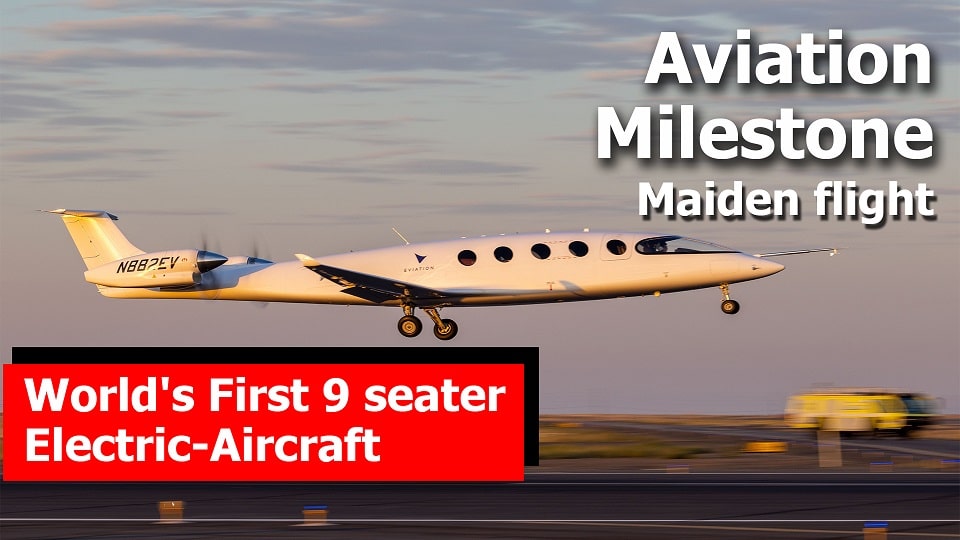Aerospace
World’s first 9-seater electric aircraft Successful First Flight of Zero-Emission #electricaircraft
Eviation Aircraft, a manufacturer of all-electric aircraft, successfully completed the first flight of its zero-emission Alice aircraft, a historic day and major milestone in electric aviation.

Moses Lake, Washington, U.S. – September 27, 2022 – Eviation Aircraft, a manufacturer of all-electric aircraft, successfully completed the first flight of its zero-emission Alice aircraft, a historic day and major milestone in electric aviation. Alice lifted off at 7:10 a.m. from Grant County International Airport (MWH), flying for 8 minutes at an altitude of 3,500 feet. This trailblazing flight of the technology demonstrator provided Eviation with invaluable data to further optimize the aircraft for commercial production.
Fly the Future: Transforming Regional Travel
All-electric aircraft will make regional travel more economically and environmentally sustainable for businesses and consumers. This new generation of aircraft has the power to transform communities by providing access to airports not currently used by commercial flights due to noise concerns or restricted operating hours. Eviation Alice is targeted at commuter and cargo markets, and will typically operate flights ranging from 150 miles to 250 miles.
Cape Air and Global Crossing Airlines, both US-based regional airlines, have placed orders for 75 and 50 Alice aircraft respectively. DHL Express is Eviation’s first cargo customer, with an order of 12 Alice E-cargo planes. With this engagement DHL aims to establish the first electric express network, leading the way for a new era of zero-emissions air freight.
Designed from Ground Up to Transform Travel
The all-electric Alice aircraft features:
● Max operating speed: 260 knots
● Max useful load: 2,500 lbs for the passenger version and 2,600 lbs for the eCargo version Alice is available in three variants including a nine-passenger commuter, an elegant and sophisticated six-passenger executive cabin, and an eCargo version. All configurations support two crew members. The executive cabin and eCargo variations are identical to the commuter configuration, except for the interior.
Alice is powered by two magni650 electric propulsion units from magniX, the only flight-proven electric
propulsion system at this scale. Other key suppliers include AVL (battery support), GKN (wings),
Honeywell (advanced fly-by-wire system, flight controls, and avionics), Multiplast (fuselage), Parker
Aerospace (six technology systems), and Potez (doors).

Aerospace
Boeing Transfers Rocket Stage to NASA, Paving Way for Human Moon Mission

Boeing has achieved a significant milestone by providing NASA with the second core stage of the Space Launch System (SLS) rocket.
This crucial component, crafted at NASA’s Michoud Assembly Facility (MAF), is set to propel the Artemis II crew into lunar orbit, marking humanity’s return to deep space after a 50-year hiatus.
The monumental Boeing-built rocket stage, the largest element of the Artemis II mission, will embark on a journey aboard the Pegasus barge, traveling 900 miles to NASA’s Kennedy Space Center.
Comparison of two legendary aircraft B777x vs B747 aircraft:Click here
Upon arrival, it will be meticulously integrated with other essential Artemis II components, including the upper stage, solid rocket boosters, and NASA’s Orion spacecraft within the iconic Vehicle Assembly Building. This intricate integration process is a vital step toward the eagerly anticipated Artemis II launch, slated for 2025.
“Boeing-built products helped land humankind on the moon in 1969, and we’re proud to continue that legacy through the Artemis generation,” remarked Dave Dutcher, vice president and program manager for Boeing’s SLS program. “Together, with NASA and our industry partners and suppliers, we are building the world’s most capable rocket and paving the way to deep space through America’s rocket factory in New Orleans.”
NASA, Lockheed Martin Reveal X-59 Quiet Supersonic Aircraft:Click here
The delivery of Core Stage 2 marks a significant achievement in the evolution of the SLS rocket. Towering over 200 feet and powered by four RS-25 engines, this core stage, coupled with two solid-fueled booster rockets, will generate a staggering 8.8 million pounds of thrust. This immense power is crucial to launching Artemis II and future missions into the vast expanse of space.
The SLS rocket stands unparalleled in its capability to transport both crew and substantial cargo to the moon and beyond in a single launch. Its extraordinary capacity will facilitate the delivery of human-rated spacecraft, habitats, and scientific missions to destinations including the moon and Mars, ushering in a new era of space exploration.
-

 Travel1 week ago
Travel1 week agoAir India to Expand US Operations with Three New Routes After a Decade
-

 Travel2 weeks ago
Travel2 weeks agoWhy We Should Avoid These Stamps in a Passport
-

 Airlines1 month ago
Airlines1 month agoInvestigations Reveal Fake Chinese Titanium in Boeing and Airbus Jets
-

 Tech4 weeks ago
Tech4 weeks agoChina’s CATL Plans 1,800-Mile Electric Plane Launch by 2027
-

 Airport3 days ago
Airport3 days agoTop 10 Largest Airports in the World by Size
-

 Aerospace4 weeks ago
Aerospace4 weeks agoChina’s Fighter Jets Turn Wings into Autonomous Drones
-

 Airlines4 days ago
Airlines4 days agoAir India Rolls Out A350s for Delhi-New York JFK and Newark Routes
-

 Defence3 weeks ago
Defence3 weeks agoBoeing Enhances Chinook with New Engines and Block II Upgrades at $96 Million







